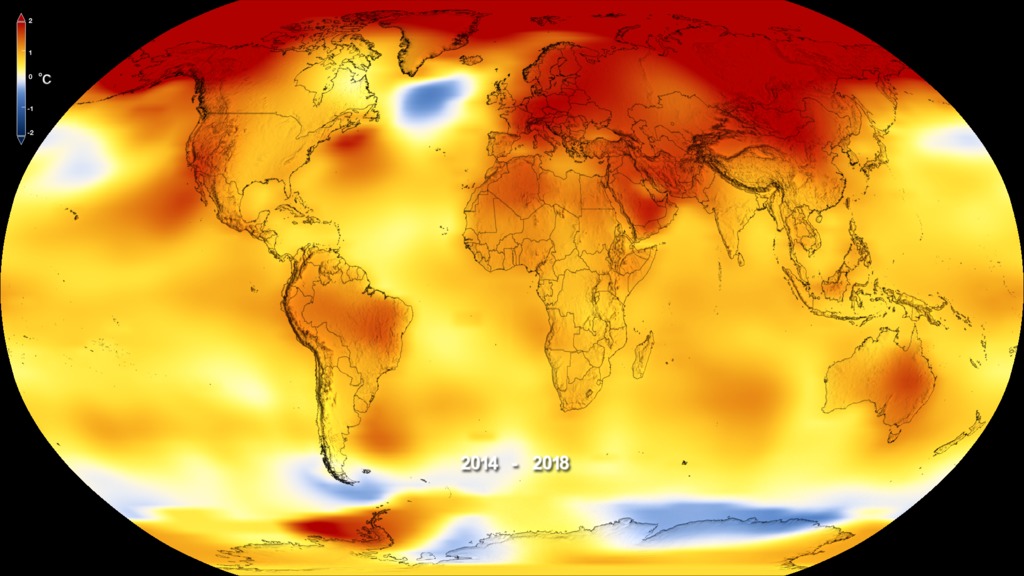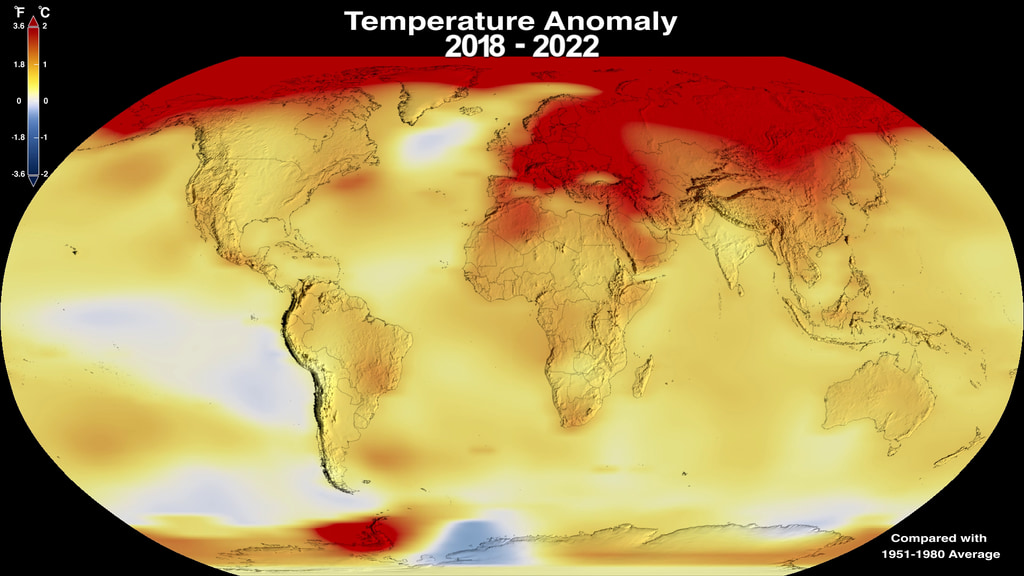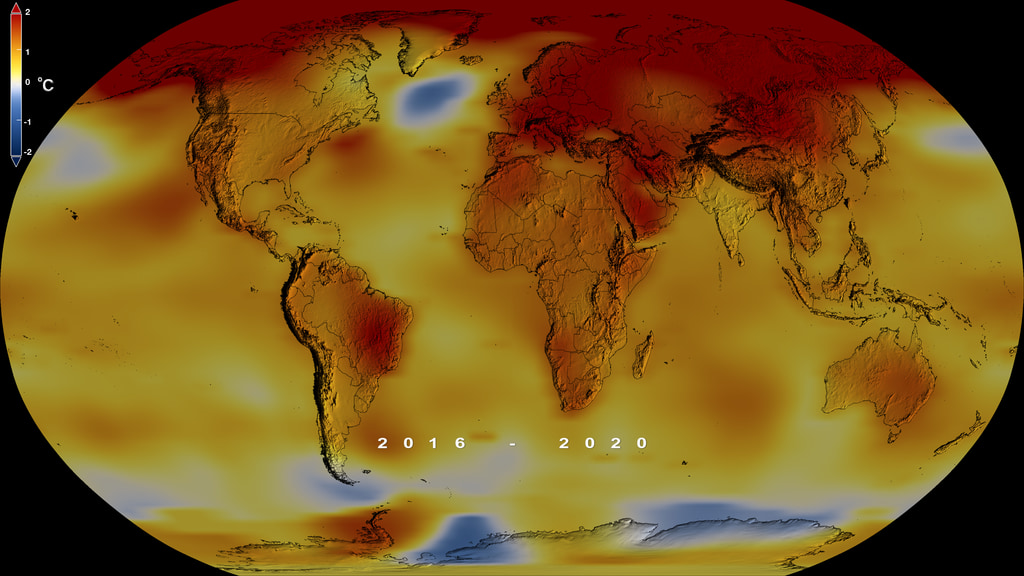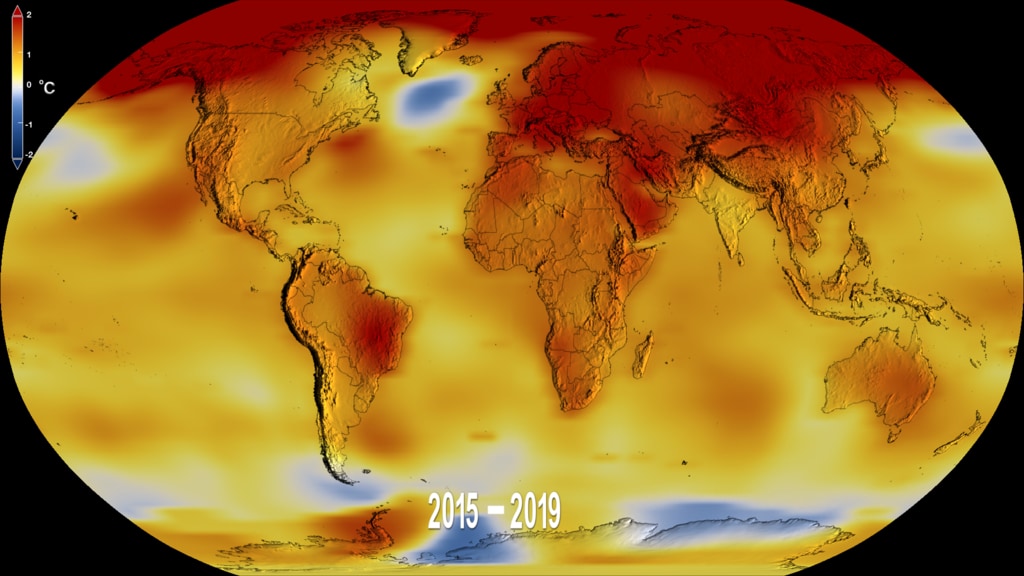A newer version of this visualization is available.
Five-Year Average Global Temperature Anomalies from 1881 to 2007
Each year, scientists at NASA Goddard Institute for Space Studies analyze global temperature data. A rapid warming trend has occurred over the past 30 years, and the eight hottest years on the GISS record have occurred in the past decade. 2005 is the hottest year on record, and 2007 is tied with 1998 for second place. The Earth is experiencing the warmest level of the current interglacial period, or interval between ice ages, which has lasted nearly 12,000 years. This color-coded map displays a long term progression of changing global surface temperatures, from 1881 to 2007. Dark red indicates the greatest warming and dark blue indicates the greatest cooling.
This data visualization of global temperature differences from 1881 to 2007. Dark blue areas show regions where the temperature was cooler then the average temperature. Red areas show regions where the temperature was warmer then the average.
This visualization shows the same data as the above visualization, but it does not annotate the date of the data.
Frame Series at 2048 by 1024 for the Science On a Sphere Display

Temperature Color bar

Print resolution still of global temperature anomalies averaged from 1881 to 1884.

Global Temperature Anomalies averaged from 1886 to 1890.

Global Temperature Anomalies averaged from 1896 to 1900.

Global Temperature Anomalies averaged from 1906 to 1910.

Global Temperature Anomalies averaged from 1916 to 1920.

Global Temperature Anomalies averaged from 1926 to 1930.

Global Temperature Anomalies averaged from 1936 to 1940.

Global Temperature Anomalies averaged from 1946 to 1950.

Global Temperature Anomalies averaged from 1956 to 1960.

Global Temperature Anomalies averaged from 1966 to 1970.

Global Temperature Anomalies averaged from 1976 to 1980.

Global Temperature Anomalies averaged from 1986 to 1990.

Global Temperature Anomalies averaged from 1996 to 2000.

Global temperature anomalies averaged from 2003 to 2007.
- Biosphere
- Climate
- Climate Change
- Climate Indicators
- Coastal Processes
- Earth Science
- Ecological Dynamics
- El Nino Southern Oscillation
- Extinction
- For Educators
- Global Warming
- HDTV
- iPod
- Land Surface
- land surface temperature
- Land Temperature
- Oceans
- Physical oceanography
- Science On a Sphere
- Sea Level Rise
- SOS
- Teleconnections
Credits
Please give credit for this item to:
NASA/Goddard Space Flight Center Scientific Visualization Studio
Data provided by Robert B. Schmunk (NASA/GSFC GISS)
-
Animators
- Lori Perkins (NASA/GSFC)
- Alex Kekesi (Global Science and Technology, Inc.)
-
Scientists
- James Hansen (NASA/GSFC GISS)
- Makiko Sato (NASA/GSFC GISS)
- Reto A. Ruedy (NASA/GSFC GISS)
- Ken Lo (NASA/GSFC GISS)
- David Lea (University of California, Santa Barbara)
- Martin Medina-Elizade (University of California, Santa Barbara)
Release date
This page was originally published on Wednesday, January 16, 2008.
This page was last updated on Wednesday, May 3, 2023 at 1:55 PM EDT.
Series
This page can be found in the following series:Related papers
http://www.nasa.gov/topics/earth/features/earth_temp.html
http://www.nasa.gov/topics/earth/features/earth_temp.html
Datasets used
-
GISTEMP [GISS Surface Temperature Analysis (GISTEMP)]
ID: 585The GISS Surface Temperature Analysis version 4 (GISTEMP v4) is an estimate of global surface temperature change. Graphs and tables are updated around the middle of every month using current data files from NOAA GHCN v4 (meteorological stations) and ERSST v5 (ocean areas), combined as described in our publications Hansen et al. (2010), Lenssen et al. (2019), and Lenssen et al. (2024).
Credit: Lenssen, N., G.A. Schmidt, M. Hendrickson, P. Jacobs, M. Menne, and R. Ruedy, 2024: A GISTEMPv4 observational uncertainty ensemble. J. Geophys. Res. Atmos., 129, no. 17, e2023JD040179, doi:10.1029/2023JD040179.
This dataset can be found at: https://data.giss.nasa.gov/gistemp/
See all pages that use this dataset
Note: While we identify the data sets used on this page, we do not store any further details, nor the data sets themselves on our site.




